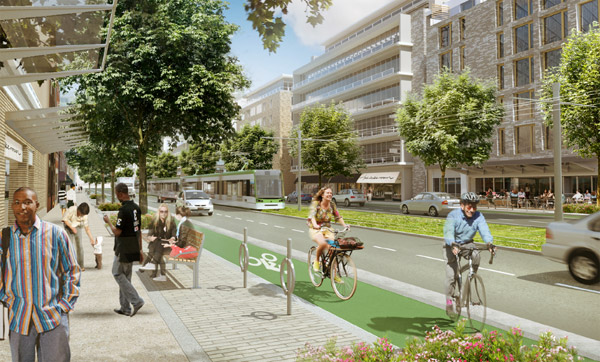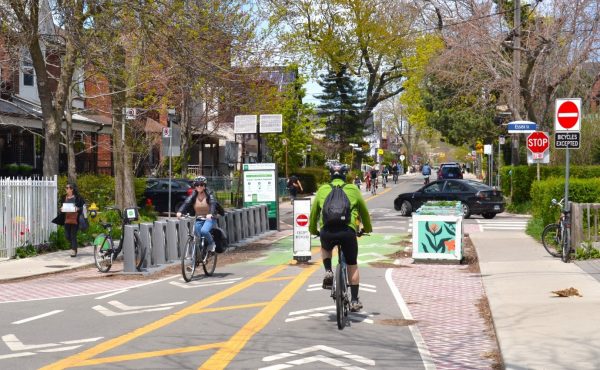This morning, the Toronto Centre for Active Transportation (TCAT) released the results of a survey of council and mayoral candidates that asked 12 questions about sustainable transportation policies (walking, cycling, transit). The survey was developed as a partnership between TCAT, Walk Toronto and Canada Walks (walking questions), Cycle Toronto (cycling questions) and the Toronto Environmental Alliance (transit questions). (Disclosure: I was part of the committee that established this survey, representing Walk Toronto).
Overall, the survey showed strong support for sustainable transportation policies, with all of the proposals receiving majority support and several of them receiving overwhelming support.
The highest support (97%, and 100% of responding incumbents) was for establishing School Travel Plans to improve the safety of children walking to school.
Several policies received around 90% support:
- Do you support enabling neighbourhoods to establish “slow zones” (with a maximum speed of 30 km/hr) on residential roads? (92%, and 100% of responding incumbents)
- Do you support connecting major transit hubs in North York, Scarborough and Etobicoke with protected bike lanes and bicycle boulevards enabling Torontonians to bike to transit as part of their commute? (89%)
- Do you support the inclusion of a Complete Streets policy into Toronto’s new Official Plan as part of the current Five Year Official Plan Review? (89%)
- Will you agree to improving transit service levels every year, beyond keeping up with increased ridership? (90%)
The lowest levels of support were for a 4-year TTC fare freeze (58%), stopping the privatization of TTC operations (73%, but 88% of incumbents), and funding residential sidewalk snow clearing by the City in old Toronto (73%, but 83% of incumbents).
Almost two-thirds (63%) of the 38 incumbents who had registered to run again for office by the time the survey closed filled out the survey. Two of the three remaining leading mayoral candidates also filled it out — Olivia Chow and John Tory — although both declined to say “Yes” or “No” to several of the questions (they did comment on all of them). David Soknacki also completed the survey before he withdrew from the race. Rob Ford did not fill it out before withdrawing, and the survey closed before Doug Ford entered the race. Overall, 39% of candidates who had registered by the time the survey closed responded to the survey.
You can see the responses for council candidates and mayoral candidates on the TCAT website. For those wishing to dig into the details, the full results are also available as a spreadsheet.
Given the strong support for sustainable transportation overall, and the overwhelming support for certain policies, we should reasonably expect to see at least some of these policies implemented during City Council’s next term.
Image: City of Toronto






3 comments
With some respect to those catalyzing the survey, and those responding, there is a sense of more sustain-the-bull vs. an appetite to really change things in the ways that are needed, some of which should have been done a decade or two ago, or even keeping the Vehicle Registration Tax. Do we not already have Official Plan statements that resonate greatly with the Complete Streets jargon now in vogue? (and where it seems that the revised OP has rather weak to pathetic statements on doing cycling things).
Let us look more at what has been done: largely ignoring the Places to Grow Act (3.2.2 and 3.2.3 especially) in the many repavings with some salient blown opportunities/flauntings egs Bloor St. W., Queen’s Park Crescent and the Gardiner. And rather than doing a larger part of the bike lanes with cheap paint to begin to catch up to the goals of the Bike Plan, we’ve been sucked into doing costly rebuilds of existing lanes with separations with the one exception of the pilot of Richmond and Adelaide, which is a truncated pilot only, though still nice, yes. So with all the knowledge and the activities of some advocates etc., even candidate Chow points to only 2 kms of new bike lane.
We also are likely sucked into voting for this and that candidate but ignore the blighting effects of major major projects that are wa$tes like the Scarborough subway extension, and also the gifts of the Gardiner repairs with no tolls for largely out-of-town commuters. Odds are high that some of the respondents will be all in favour of this and that, but gee, no money.
A much better indicator of where folks stand is likely with a Vehicle Registration Tax – and see how few candidates/incumbents actually stand up to that litmus test, even if it were tweaked to pump the millions into the TTC. And I have favoured Bloor/Danforth bike lanes for a decade plus, also in the realization that this is a subway relief bikeway, or would be for the price of paint – and while we are now at the point of getting back to another study shunted past this election – if there’s money – in the meanwhile there’s nothing to improve bike safety in the most needed part west of Ossington where Harbord ends. Some advocates pushed trial Bloor bike lanes though, east of Ossington where Harbord is a fine facility relative to everything else in the west end.
At times, it’s not OK to call us Caronto, but instead let us rename us “Moronto”
Hamish, decent bike lanes on Bloor are to some extent a subway relief, but they will also enable more people to conveniently access the subway. Leading to more subway passengers.
This is the same effect as improving the subway feeder bus service.
I do not know which will be larger: The number of people using a Bloor cycle track instead of the subway? OR the additional passengers using the subway because they now have easier access to it due to a Bloor cycle track?
A praiseworthy effort of the advocates to survey election candidates on sustainable transportation, and as expected, very politically savvy of the candidates to support strongly almost all concerns.
However, the City of Toronto has always excelled in rhetoric but consistently fell behind in action. And presently, in an effort to impress us of gaining progress, it has engaged in popular semantics, as in Walkable communities or Complete Streets. We have neither walkable communities nor sustainable transportation, due to prioritizing driving vs all other modes of transportation. Furthermore, we are increasing driving speed to 60Ks/hr on city streets….
And this mentality is exacerbated and prolonged by the ambivalence of our city planning in proclaiming to transform the city, yet not adhering to the concept of sustainable transportation. Ms. Keesmaat’s declaration on what pertains to “Walkable”, is semantics in an exercise of distraction and disarrangement of the very notion of walkable cities around the world. Walkability does not refer to the walking distance to public transit, nor to the assurance that crossing the street on Green light will not get you killed. It refers to infrastructure change in the design of car-free areas in a city, to acquire a people-friendly urban environment that creates social cohesiveness and a liveable city.
European cities and around the world, have successfully implemented car-free areas demonstrating an innovative and progressive vision as the best environmental design in improving public life and alleviating congestion without limiting mobility, and by increasing cycling traffic to 40% not to the dismal fragmented and incoherent few bike lanes we have in this city.